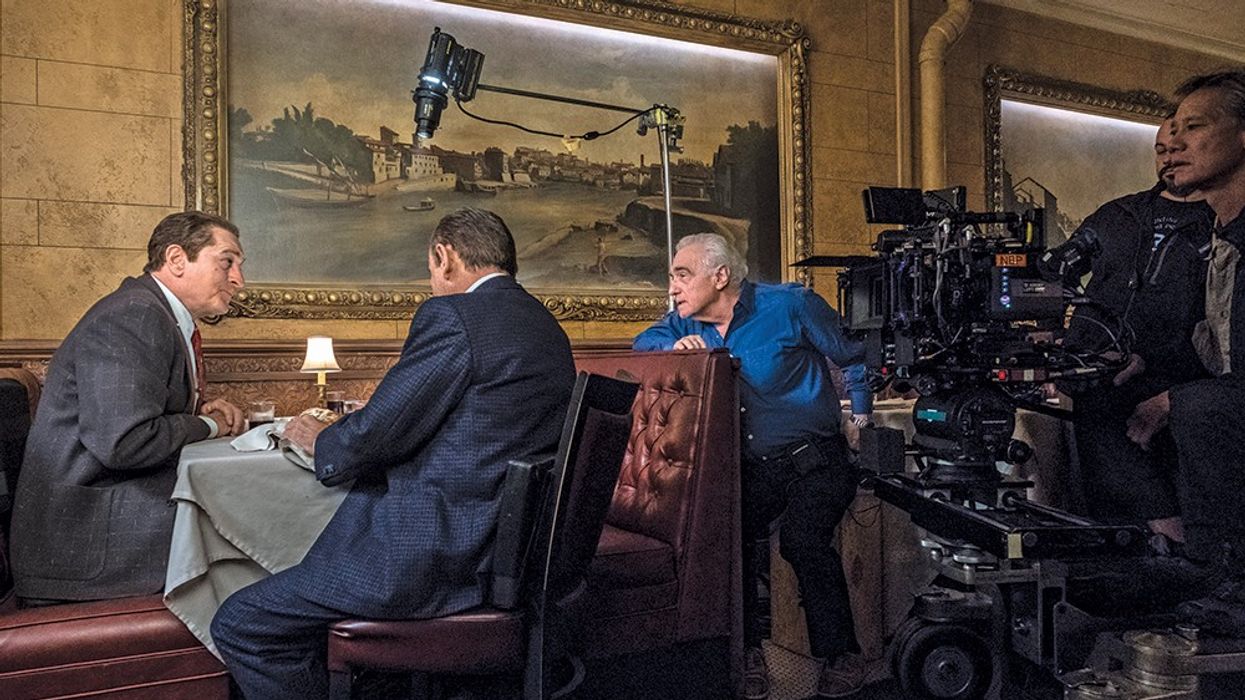Find Out the Filmmaking Techniques Behind Scorsese's 'The Irishman'
Let's talk about how The Irishman was shot and edited, and what that means for the story.

Martin Scorsese’s 2019 film, The Irishman, didn’t take home any Oscars in February 2020, but it is certainly a film that will be long remembered and studied—perhaps even more so than the film that did go on to win Best Picture that year.
As noted by director Guillermo del Toro on his Twitter account: “This film [The Irishman] needs time – however – it has to be processed like a real mourning. It will come up in stages… I believe most of its power will sink in, in time, and provoke a true realization. A masterpiece.”
But how did Scorsese pull off his latest masterpiece? Following my previous Martin Scorsese video in which I highlighted a number of the editing techniques visible in his narrative feature films—from Who’s That Knocking at My Door (1967) to Silence (2016)—I decided to look at some of the filmmaking techniques in The Irishman.
Watch the video below and then dive into some of the key takeaways!
Familiar Editing Techniques
Martin Scorsese and his editor Thelma Schoonmaker have such a distinct way of piecing shots together. They have a number of techniques that they frequently employ—their work often utilizes freeze-frames, jump cuts, visual discontinuity, flash cuts, and dissolves—and many of these visual tricks are also present in The Irishman.
First up, freeze-frames. From Goodfellas to The Wolf of Wall Street, freeze-frames are often utilized by Scorsese and Schoonmaker. However, The Irishman gives them a new angle as title cards are used to state how the characters in the freeze-frame will meet their end.
Death is a theme that hangs over the entire film, from the opening Steadicam shot through a care home, followed by Frank (Robert De Niro) recalling a murder years before, to scenes later in the film in which Frank chooses a coffin and picks out a place in a mausoleum. The title cards over the freeze-frames help to reinforce this theme.
Another familiar editing technique—one that I didn’t mention in my first Scorsese video—is a technique I’ve labeled the "Abrupt Music Cut."
A song or piece of music can be heard over a scene, but then Scorsese brings the track to an abrupt end. We see/hear this technique in The Wolf of Wall Street where it is used for comedic effect: a song blares out as Donnie (Jonah Hill) rants and raves on an office desk but the song ends when we cut to Jordan (Leonardo DiCaprio) being interviewed by the FBI.
In The Irishman the abrupt music cut is used for humor, but, in one scene, it is used to raise tension.
Scorsese uses music to move a number of scenes along at a leisurely pace but the track comes to an abrupt end once Jo Hoffa puts her car key in the ignition. Suddenly, tension increases as she and we, the audience, realise that the car could have a bomb in it.

Looks and Cuts
Scorsese is a filmmaker who thinks long and hard about the progression of shots and the meaning that will occur in the mind of the audience as a result of two shots being placed next to each other.
He noted this during an interview with Charlie Rose: “[Filmmaking] it’s the—literally—the imagining of shots—one shot being cut to the other and the emotional and psychological impact of that cut.”
The Irishman is a masterclass in how to create meaning and move the story along via the look of the actors and precise editing.
For example, following an encounter with "Crazy Joe" in a comedy club, Frank sits across from Russ (Joe Pesci). With a single look from Joe Pesci—without dialogue—the audience realizes that Russ wants Frank to kill Crazy Joe. We then see a single shot of Frank. We know that he too understands what Russ wants. The filmmakers then cut to a shot of a variety of guns laid out on a bed.
In just three shots, Scorsese and Schoonmaker have set up the next scene, which is the murder of Crazy Joe.

Themes
Editing is also used to strengthen ideas and themes. For example, we see Frank discussing stealing meat for some local gangsters, but then Scorsese and Schoonmaker cut to the christening of one of Frank’s children. This cut isn’t by chance, as crime and religion have long been a part of Scorsese’s work. But here, the edit demonstrates the hypocrisy of Frank. He christens his child even though he is a criminal.
Another example of editing creating ideas and reinforcing themes can be found in the intercutting between a bygone Christmas and scenes of Frank recalling business dealings while in a care home.
By splicing in brief shots of Christmas, the editing replicates the idea that Frank was never present when it truly mattered: the moments with his family should’ve dominated, but work came first, and later on in the film we see Frank dealing with the repercussions of those life choices.

Summary
Those are just some of the techniques used in Scorsese’s The Irishman. Like Guillermo del Toro, I will continue to process this masterpiece, letting it sink in, provoke me, and inform my approach to filmmaking.
What have you learned from this film? Let us know in the comments.

 "'Back Home"via Mercedes Arutro
"'Back Home"via Mercedes Arutro 'Back Home'via Mercedes Arutro
'Back Home'via Mercedes Arutro 









